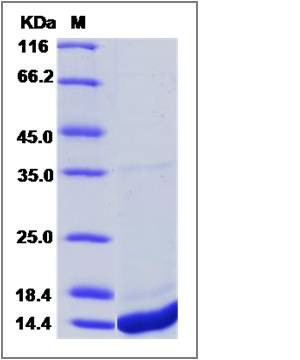Human S100A8 / CAGA / p8 Protein (His Tag)
60B8AG,CAGA,CFAG,CGLA,CP-10,L1Ag,MA387,MIF,MRP-8,MRP8,NIF,P8
- 100ug (NPP4237) Please inquiry
| Catalog Number | P11138-H08B |
|---|---|
| Organism Species | Human |
| Host | Baculovirus-Insect Cells |
| Synonyms | 60B8AG,CAGA,CFAG,CGLA,CP-10,L1Ag,MA387,MIF,MRP-8,MRP8,NIF,P8 |
| Molecular Weight | The recombinant human S100A8 consists of 103 amino acids and predicts a molecular mass of 12.2 kDa. It migrates as an approximately 14.6 kDa band in SDS-PAGE under reducing conditions. |
| predicted N | Met |
| SDS-PAGE |  |
| Purity | > 90 % as determined by SDS-PAGE |
| Protein Construction | A DNA sequence encoding the human S100A8 (NP_002955.2) (Met 1-Glu 93) was expressed, fused with a polyhistidine tag at the C-terminus. |
| Bio-activity | Measured by its ability to bind recombinant human S100A9 in a functional ELISA. |
| Research Area | Epigenetics |Cell cycle |Cell Differentiation |
| Formulation | Lyophilized from sterile 20 mM Tris, 500 mM NaCl, 10 % glycerol, pH 8.0. 1. Normally 5 % - 8 % trehalose, mannitol and 0.01% Tween80 are added as protectants before lyophilization. Specific concentrations are included in the hardcopy of COA. |
| Background | S100A8 is a member of the S100 protein family containing 2EF-hand calcium-binding motifs. S100 proteins are involved in the regulation of a number of cellular processes such as cell cycle progression and differentiation. Altered expression of S100A8 protein is associated with various diseases and cancers. S100A8 may have an immunoregulatory role by contributing to the regulation of fetal-maternal interactions. It may play a protective role and its absence may allow infiltration by maternal cells, a process eventually manifesting as resorption. The heterodimeric S100 protein complex S100A8/A9 which has been shown to be involved in inflammatory and neoplastic disorders. The complex can induce cell proliferation, or apoptosis, inflammation, collagen synthesis, and cell migration. S100A8/A9 has emerged as important pro-inflammatory mediator in acute and chronic inflammation. More recently, increased S100A8 and S100A9 levels were also detected in various human cancers, presenting abundant expression in neoplastic tumor cells as well as infiltrating immune cells. On the one hand, S100A8/A9 is a powerful apoptotic agent produced by immune cells, making it a very fascinating tool in the battle against cancer. It spears the risk to induce auto-immune response and may serve as a lead compound for cancer-selective therapeutics. In contrast, S100A8/A9 expression in cancer cells has also been associated with tumor development, cancer invasion or metastasis. Altogether, its expression and potential cytokine-like function in inflammation and in cancer suggests that S100A8/A9 may play a key role in inflammation-associated cancer. |
| Reference |
